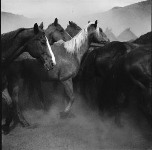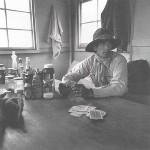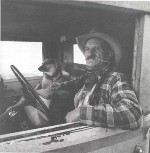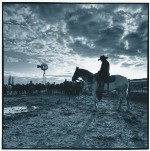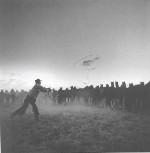Spring 2000, Volume 17.3
Art
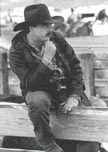
Adam Jahiel
Ranch Photographs
A resident of Story Wyoming, Adam Jahiel received his B.S. from Brooks Institute of Photography and B.J. from the University of Missouri. He is a free-lance photographer doing entertainment, magazine, advertising and corporate photography. His work has appeared in major U. S. publications and dozens of books. He is represented by some of the best photography galleries in the world.
[Click on photos to enlarge.]
It was 1974. I must of been 16 years old, and on my first major road trip— driving west to meet my Uncle in Utah and go fishing at Lake Powell. I had a `69 Chrysler Newport 2-door and a buddy of mine who was on his way to Arizona. After I dropped him off in Green River, I headed south all by myself. I remember listening to a tape of Handel's "Water Music" that my mom had given me, and I was driving, and everything was just incredibly big—massive red rocks, vast sky, and you didn't see a soul for hours. That space and solitude just felt right. That's what put the hook in me, and ever since I've had a need for that kind of western space.
I'd been fascinated with documentary photography for years. Some of my heros when I was younger were people like Dorothea Lange, Walker Evans and the Farm Security Administration people—I loved the grit and soul of those black and white photographs.
There is something that I find very compelling, an almost Zen-like about ranch hands. They are not caught up in materialism or status seeking. And because their world is limited in distractions, what they do, they do well, completely and thoroughly.
The West is a world where points on the map are far apart, where the country is vast, the skies huge, and where, in the scale of things, men become insignificant. Out away from town, there are no pay phones, cell phones, computers or backups. Nobody to flag down if you run out of gas or water. If you get lost, you're lost. If you're bucked off and your horse runs, you better start walking.
When I was in California I spent a lot of weekends in the Los Padres Mountains above Santa Barbara. My friends had horses and we would ride and rope and go to rodeos—and, of course I took pictures. There was something interesting to me about cowboys and the whole "western" thing—these were people who weren't afraid of getting their hands dirty, who had to deal with animals and weather and nature, and not the artificial environment of a business office or computer laboratory.
Fringe cultures—groups of people who exist outside of the conventional world—have always been interesting to me. Maybe my coming of age in the early 70's made me dislike mass-anything. In the world that I live in and photograph, the individual reigns.
The way I got started with cowboy pictures, I had an assignment to photograph a rodeo bull at a ranch along the California- Nevada border, up close to Susanville. The owner showed us around, and I remember we walked into the cookhouse to get a cup of coffee. There was a small living area with a dart board and a bunch of cowboy hats and chaps and gear, then we walked into the actual dining area which had a giant picnic table covered by a red and white checkered plastic table cloth. The walls were wood panels painted white with no adornment. And there was something so incredibly, wonderfully stark and western about the whole space—very minimal, and I thought, this would be a wonderful subject to sink my teeth into. As it turned out, the owner of the bull owned or leased a third of the ranches in Nevada. One visit lead to another, and pretty soon I had a passport to go to any of their ranches and photograph.
Sometime later, I heard about another rancher, and I went there late one night, and the cow-boss, one of these older gruff western guys said, "Breakfast is at 4:00." I pitched my tent and the next morning I woke up about 3:30 to the sounds of jingling spurs walking by my tent and the shadows cast by Coleman lanterns these guys carry around in the morning. I went into the cook tent and kind of stood around till the cow-boss said, "Grab a cup of coffee." I got a cup of coffee, and he said, "You can sit over there in the chair by the door, that's where the new guys sit." And that was the end of our conversation for the day. This went on for 10 days until I had taken enough photographs. As they were getting ready to go out that last morning, I said "I think I've got enough material so I'm going to go back home." And the cow boss kind of nodded, "yeah," but before they rode off he came back around and said, "You want to shoot on any other ranches around here, like the YP up the road? You can use me as a reference." He rode off, and I realized that what this man had said in a very western way was really high praise. And so the next trip I went up to the YP Ranch, and I said, "Bill Maupin, suggested that I could talk to you." And the response was, "If Bill put up with you for 10 days, we'll put up with you. That's how it went.
For most of my pictures, I use a medium format rangefinder camera, with maybe three lenses and a few filters, usually yellow or orange to make the sky pop out a little. It's a less is more kind of thing with me. The rangefinder is quiet and unobtrusive and it's also vibration free, so I can shoot in fairly low light situations at a slow shutter speed without worrying about mirror shake. The larger the format, the less depth of field you have, and I really like that for a number of reasons. In a lot of the closer up pictures, the focus kind of isolates the subject and that works for me because a lot of my subject matter is isolated to begin with.
The ranching world may be diminishing in its national import, but it is an intensely real world. Here life is dictated mostly by nature. There are no time clocks to mark the beginning and end of work here, no employee booklets to dictate what a person's responsibilities are. Here, people are still largely at the mercy of weather, daylight, terrain, and the physical limitations of man and animal.
About the square format, it's funny, I've used all sorts of formats, 35mm, 4x5, but when I picked up my present Mamiya, it just felt right. It was incredibly comfortable. There's no turning it sideways, so you don't have to think horizontal or vertical, basically you just frame your subject and shoot. I get indecisive with a 35mm camera, plus you have too many pictures to take on a roll, 36 as opposed to 12. Any way, the square format just fits like an old shoe.
Years ago I took a trip, I taught on the Semester at Sea program with the University of Pittsburgh and I ran around the country—around the world actually— with a small Leica using black and white film and one lens, and I did some of the best shooting I've ever done in my life. The lesson I got from that trip is less really is more.

